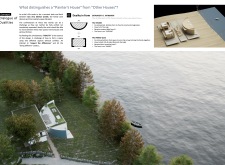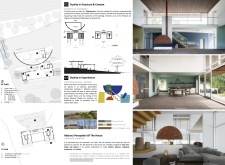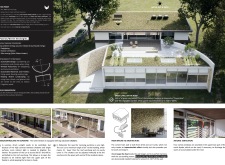5 key facts about this project
As a multifaceted structure, the project primarily functions as a [insert function, e.g., community center, office building, educational facility, etc.], designed to accommodate various activities and foster interaction among its users. The layout thoughtfully organizes spaces to enhance usability while promoting a sense of community and collaboration. Key areas within the design include [describe important spaces, e.g., open gathering areas, private meeting rooms, leisure zones], each meticulously planned to serve distinct purposes while maintaining fluidity and coherence throughout the structure.
The design represents a commitment to sustainable practices and environmental sensitivity. The architects have integrated natural light and ventilation generously throughout the interior, facilitating an energy-efficient environment that reduces reliance on artificial heating and cooling systems. This focus on sustainability is evident in the use of responsibly sourced materials and construction techniques that aim to minimize the ecological footprint of the building. Elements such as reinforced concrete provide structural stability, while large expanses of glass invite light into the spaces, creating a connection that draws the landscape into the building and enhances the occupants’ experience.
One of the unique design approaches employed in this project lies in its materiality. The careful selection of materials not only contributes to the aesthetic appeal but also emphasizes the building’s functionality and emotional resonance. For instance, the use of warm woods alongside sleek metals and expansive glass areas creates a dialogue between traditional and contemporary architectural expressions. This juxtaposition is deliberate, aiming to foster a sense of continuity with the surrounding environment while also addressing modern sensibilities.
Moreover, the project incorporates innovative design features that enhance the user experience. The incorporation of flexible spaces allows for a variety of uses, catering to both individual and group activities. Movable partitions enable the adaptation of spaces according to the need, enhancing the multifunctional nature of the structure. Special attention has also been given to acoustic design, ensuring that areas designated for gathering and interaction maintain a comfortable sound environment, promoting effective communication and engagement.
Landscaping plays a pivotal role in the overall design narrative, as the project seamlessly integrates outdoor spaces with the interior environments. This fusion extends the usable area and encourages outdoor activities, reinforcing the building's role as a community hub. The thoughtful positioning of windows and terraces not only frames picturesque views of the landscape but also encourages occupants to inhabit these outdoor spaces, further enhancing their connection to nature.
In summary, this architectural project stands as a testament to thoughtful, user-centered design that marries form and function. It actively engages with its environment and community aspirations, fostering a spirit of cooperation and shared experience. As you explore this project further, take the opportunity to review architectural plans, architectural sections, architectural designs, and architectural ideas to gain deeper insights into the intentions behind this carefully crafted work.


























